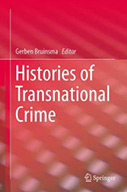Histories of Transnational Crime

Editor: Gerben Bruinsma
Publisher: New York: Springer, 2015. 188p.
Reviewer: Philip L. Reichel | March 2016
Gerben Bruinsma, noted criminologist and past president of the European Society of Criminology (2014-2015), has assembled a diverse group of experts to provide interesting and thought-provoking chapters for this edited volume. Importantly, for this reviewer, a brief biography for each contributor is provided in the Front Matter, thus allowing the reader to appreciate each contributor’s background and expertise before rather than after reading a chapter. Chapters 1 and 8 serve as the book’s introduction and conclusion (albeit without those labels), whereas the remaining chapters provide a historic base for specific examples of transnational crime.
In the first chapter, Bruinsma introduces the topic of transnational crime and carefully notes how the concept presents problems of definition—regarding both the incident and the perpetrators. In addition, the chapter includes a section on some barriers and limitations to the understanding of transnational crime. By highlighting the limited number of research designs available to those studying transnational crime, and such barriers as a lack of specificity regarding the units of analysis and the lack of researcher access to multi-country data, Bruinsma reminds us that our knowledge of transnational crime tends to be one-sided and biased. In addition, he notes that most studies on transnational crime are a-theoretical and a-historical. That second point provides the motivation for this book and declares the editor’s goal of presenting historical studies that inform us about the roots of phenomena that are too often viewed only in their contemporary form. The volume has three main objectives: (1) Describe and uncover the historical roots of transnational crime as it is understood today; (2) Put transnational crime in its proper and complete context; and (3) enrich theoretical notions regarding the etiology of transnational crime.
Chapter 1 concludes with a brief overview of the remaining chapters. For each, the editor identifies the transnational crime addressed and highlights key points made in the chapter. Since the table of contents shows no summary or conclusion by the editor at the book’s end, it would be useful in this section of Chapter 1 to include brief comment as to how each chapter helps achieve one or more of the volume’s three objectives. If those objectives are important enough to highlight and explain in the introduction, they should be highlighted as well for each chapter—at least by the editor if not the authors.
Bruce Elleman covers maritime piracy in Chapter 2. He begins with the very compelling point that twenty-first century piracy, if unabated, could threaten world finances and regional development. The chapter begins with early historical cases, divided by region, then examines more contemporary cases. Noting that the definition of piracy changes over time, Elleman explains that under some definitions piracy can only occur in rather specific situations (e.g., outside the jurisdiction of any state and involving perpetrators on a ship or aircraft attacking another ship or aircraft), but that other definitions include as piracy attacks from shore or attacks when the victim is docked. The importance of definition is apparent upon realizing that the “problem” is greater or less depending on the scope of behavior that is included. Interestingly, this issue of definition occurs in several other chapters and presumably is one of those history lessons that this volume intends to highlight. The chapter concludes by noting the overlap between piracy and other transnational crimes—specifically organized crime and terrorism. As with the issue of definitions, this overlap among transnational crimes is also a recurring theme in other chapters.
Chapter 3 reviews the history of slavery, human smuggling, and human trafficking from the mid-nineteenth century to the present. Marlou Schrover explains at the start of her chapter that the point being addressed is when and why migration was framed—especially in newspapers and policy papers—in terms of slavery, smuggling, or trafficking. Persons familiar with Spector and Kitsuse’s (1973) classic article proposing a natural history of social problems will find many similarities in Schrover’s analysis of how the “problem” (whether it is called slavery, smuggling, or trafficking) is framed. Key here, as it was with piracy, are definitions and how broad definitions can make the problem more widespread, of greater public concern, requiring greater attention and funding, and assuring its continued presence.
In Chapter 4, Jonathan Grant traces small arms trafficking (firearms and ammunition) in world history. Of particular interest are attempts to restrict arms trafficking beginning in the late nineteenth-century. Grant nicely summarizes cross-national efforts of coordination and explains the political, financial, and legal issues at play. His overview makes clear that current problems with arms trafficking are not merely recent developments nor can they be attributed simply to the international consequences of Cold War rivalries.
If Cold War rivalries cannot be the primary explanation for contemporary arms trafficking, Carl Trocki suggests it did dramatically influence global drug trade and the consumption of drugs. In Chapter 5, Trocki reviews the criminalization of drugs (especially in the early-twentieth century), with an emphasis on the interplay persons operating from a “purity” motivation (e.g., religious and temperance groups) and others who were public health advocates. A decline in transnational drug trafficking into the mid-twentieth century saw a dramatic shift in the post-war era, with drug consumption and concern with that consumption increasing in the U.S. and western Europe. One factor in the increase, Trocki argues, was the “war on drugs,” which actually made heroin easier to obtain than the hallucinogens and other drugs that had been popular. Another factor was American policy during the Cold War (and continuing today), wherein American government partnerships with drug lords was deemed necessary to combat communism (or, today, terrorism). Trocki’s lesson from history is that a continued policy of viewing drug use as a criminal problem rather than a medical matter will simply (as it has consistently over time) breathe life into organized crime, corrupt police and political officials, and generally have disastrous consequences.
Chapter 6, on trafficking in stolen and looted art and antiquities, was especially informative. Noah Charney provides a historical review of the broad category of art crime, but does so with an excellent use of case studies that are used to show a specific trend or concept he is explaining. The result is a very interesting journey from looting in war as early as 212 BCE to present day examples of stolen art by individuals and criminal groups. As in the chapter on piracy, Charney suggests links between trafficking in stolen art and antiquities and other transnational crimes (drug trafficking, arms trafficking, and terrorism). He concludes with an observation that despite a recognition that art crime represents one of the highest grossing criminal trades, it remains an under-reported and under-studied activity. Governments are not dedicating resources to gathering and analyzing data on art crime. Importantly, the mechanics of art crime remain a mystery to the general public and police alike. Public opinion and government resources are not keeping pace with the growing impact of this very early example of transnational crime.
In Chapter 7, Wim Huisman, Annika van Baar, and Madelijne Gorsira begin by effectively distinguishing between the topics of corporate transnational crime and corporate complicity to transnational crime. Their chapter reviews the historical origins of business related crime in an attempt to understand better the historical context of modern corporate crime and transnational organized crime. Both are often presented as recent products of globalization, but the authors show that history actually suggests globalization may not be the culprit. As they note, as long as there have been business and regulation of business, there has been business related crime. The first recognized transnational examples are the fraud and corruption associated with seventeenth-century trading companies (the British East India Company and the Dutch Vereenigde Oost-Indische Compagnie). The chapter continues with examples of corporate complicity to transnational organized crime (a product—or at least its social construction—of the twentieth century), then explains the arguments for either making or blurring distinctions between organized crime and corporate crime. Discussion of transnational crimes is used to make points regarding ways that legal corporations might facilitate criminal organizations (money laundering) or how corporate activity can change from being legal to illegal through legislation or be argued as criminal through definition (environmental crime). A section on corruption is especially interesting as it points out that corruption has been present throughout history but today is considered at problem not only at a national level but internationally as well.
Absent any concluding comments by the editor, Chapter 8 becomes the only opportunity to provide readers with a summary of the previous chapters or, more importantly, a suggestion as to how the chapters tie together and what themes, important for today, can be identified. In his Chapter 1 overview of each chapter, Burinsma indicates that Edward Kleemans will in fact do some of this in Chapter 8 during his review of how the studies presented in chapters 2-7 can provide valuable insight about criminal organizations and transnational crime.
Chapter 8 does, in fact, include a section on “Historical Perspectives and Criminal Organization” wherein Kleemans comments on Chapters 2-6 and provides an interesting, informative, and even critical appraisal of each. Indeed, I found this section to serve as a very good book review since it has helpful summaries of each chapter but also includes comments, sometimes critical, regarding the chapter author’s argument or perspective. The first part of Chapter 8 offers a review of some major theories of organized crime. Kleemans focuses on protection theory, bureaucracy theory, illegal enterprise, criminal network theory, and situational approaches. Strengths and weaknesses of each theory are noted in relation to particular types of crime, and this section is a very helpful addition to the book. Overall, however, Chapter 8 stands more as a last chapter than an effective summary of the volume’s content and a highlighting of what has been learned by reading the chapters.
As noted in this review, several chapters highlight the implications of how transnational crimes are defined and the overlaps amongst the crimes. A concluding chapter or volume summary wherein the editor makes such observations and suggests their importance would help show the importance of an historical perspective and articulate how these chapters have met the objectives identified in Chapter 1.
History has intrinsic interest for many people; but even those who find the subject more dull than exciting might agree with the various versions of “those who ignore history are doomed to repeat it.” In that spirit, I read each chapter in anticipation of a “what this history means for today”—whether in terms of policy, enforcement, prevention, or combating. That type of analysis, or even conjecture, is unfortunately missing in most of the chapters. A few chapters make brief comment on this point. Elleman, for example, notes that terrorists may turn increasingly to piracy to fund their activities as land-based funding sources collapse. But, there really could be more of this in all the chapters.
Despite a few shortcomings, this book is an excellent addition to the literature on transnational crime. The chapters, individually and collectively, provide an important context for students, researchers, and policy-makers as each attempts a more complete understanding of transnational crime. Finally, to the publisher’s credit, an index is provided (something not always found in edited books) so that readers can find key terms occurring across chapters.
Philip L. Reichel, Emeritus Professor, University of Northern Colorado; Adjunct Professor, University of New Hampshire Law School
Spector, M., & Kitsuse, J. I. (1973). Social problems: A re-formulation. Social Problems, 21(2), 145-159.


